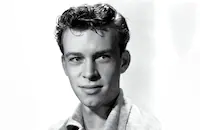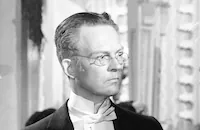Sealed Cargo

Brief Synopsis
Cast & Crew
Alfred Werker
Dana Andrews
Carla Balenda
Claude Rains
Philip Dorn
Onslow Stevens
Film Details
Technical Specs

Synopsis
In 1943, Pat Bannon, the captain of a large Gloucester, Massachusetts fishing boat, The Daniel Webster , is in desperate need of sailors and so hires Conrad, a Dane without identification papers. Pat then reluctantly agrees to take stranger Margaret McLean to Trabo, a village on the Newfoundland coast, where Pat fishes. During the voyage, a small storm hits and fog envelops the boat. Pat hears machine gun fire in the distance and suspects that German U-boats are signaling each other. When sailor Holger, another Dane, shows Pat that the boat's radio has been sabotaged, Pat questions Conrad after Holger reveals that Conrad has refused to speak Danish. The rough-hewn Conrad grudgingly utters some Danish and comments that Holger's Danish is surprisingly polished. Just then, the men hear more gunfire, and Pat realizes that the U-boats are shelling another vessel. Pat and some of his crew, including Holger and Conrad, board the wrecked vessel, which turns out to be a Danish schooner called The Gaunt Woman , and after discovering a dead man up top, locate the ship's dazed, speechless captain, Eric Skalder, down below. Once Pat has inspected the ship's cargo--barrels of costly rum--Skalder finally begins talking, describing how his schooner was blown off course during the storm and his crew abandoned ship after the shelling began. Skalder identifies the dead man as his business partner and states that the Germans planted a bomb on the schooner, which his partner found and deactivated. Skalder offers to pay Pat to tow the schooner, and Pat agrees. That night, while on the deck of The Daniel Webster , Pat notices a light being flashed through a porthole and goes below to investigate. Finding only Margaret awake, Pat questions her. Margaret explains that she is a nurse and is returning to Trabo, her childhood home, to visit her father. When Pat comments that he knows no one in Trabo named McLean, Margaret becomes defensive, claiming that her father, a sea captain who left Trabo many years before, was disabled when his ship was attacked by a U-boat. Later, in the isolated village of Trabo, Skalder accepts Margaret's father's invitation to spend the night at his house, but Pat declines and returns to search the schooner. On board Pat finds Conrad, who states that he became suspicious of Skalder's story because he had noticed bullet holes in a tarp covering a lifeboat, but none in the lifeboat itself, suggesting that the Germans had shot up the tarp while the boat was being used. The two men inspect the cargo area again and there discover a hidden door leading to a large room filled with torpedoes. Now aware of Skalder's true mission, Pat speculates that the schooner was heavily damaged during the storm because it was tied up to a submarine, so Skalder sent his crew away and ordered the shelling to explain the devastation. At that moment, as Pat and Conrad hide, Holger enters the torpedo room to send a coded message over the radio. After Holger leaves, Conrad races to warn the McLeans about the schooner, while Pat greets Skalder, who is re-boarding with his returning crew. A Canadian patrol plane then lands nearby, and the pilot informs Skalder that the schooner will be inspected the next morning. Feigning ignorance, Pat suggests that one of his Danish sailors act as a witness during the inspection, and Skalder selects Holger. Pat hurries to the McLeans', where Margaret reveals that Conrad left his flashlight in the schooner's hold. Sure that the Nazis will destroy the village when they find the flashlight, Pat prepares to shove off that night, while Margaret quietly evacuates the village. All goes as planned until Anderson, one of Skalder's men, shows up at the McLeans' claiming to need a nurse and insisting that Margaret go to the schooner. To protect Margaret, McLean reveals the location of the villagers. Hidden under the McLeans' house, Pat overhears the exchange, and as soon as Anderson leaves with Margaret, he and his crew camouflage some rowboats with gasoline-soaked brush and row out to the schooner. The men set fire to the brush, which ignites the schooner as they are boarding it. A gun battle then ensues, and after all the German crew is subdued and Margaret is rescued, Pat corners Skalder. Skalder insists that a time bomb is set to go off in twenty minutes and is powerful enough to destroy the village. Pat sends Margaret, with whom he has fallen in love, and most of his crew to help move the villagers to a high cliff and instructs Steve, another crew member, to steer the schooner toward the current. Just then, two approaching U-boats are spotted, so Pat decides to blow them up along with the schooner. Skalder, meanwhile, suddenly pulls a gun on Conrad, who is guarding him at gunpoint, and the two men shoot each other. Skalder is killed, but Pat manages to drag the wounded Conrad to a rowboat. Pat, Conrad and Steve row furiously, reaching safety moments before the bomb explodes and destroys the schooner and the submarines.

Director

Alfred Werker
Cast

Dana Andrews

Carla Balenda

Claude Rains

Philip Dorn

Onslow Stevens

Skip Homeier
Eric Feldary

J. M. Kerrigan

Arthur Shields
Morgan Farley
Dave Thursby
Henry Rowland
Charles A. Browne

Don Dillaway
Al Hill
Lee Macgregor
William Andrews
Richard Norris
Kathleen Ellis
Karen Norris
Harry Mancke

Whit Bissell
Jay Morley
Bert Kennedy
Larry Johns
Bruce Cameron
Ned Roberts
Watson Downs
Jimmy Ogg
Dick Crockett
Bob Morgan
Wes Hopper
Bob Smitts
Geza De Rosner
Robert Boone
Peter Bourne
Zachary Berger
John Royce
William Yetter
George Ovey
Carl Sklover
Bessie Wade
Art Dupuis
Crew
C. Bakaleinikoff
Mel Berns
Samuel Bischoff
Phil Brigandi
Albert S. D'agostino
Ralph Dawson
George E. Diskant
Clint Dorrington
Warren Duff
Dick Elmore
Oliver H. P. Garrett
Larry Germain
Sol Gorse
Roy Huggins
J. Mcmillan Johnson
Fred Kendar
Bert Le Baron
Nate Levinson
Bill Lewin
Carey Loftin
Gil Perkins
Clem Portman
Lloyd Richards
Dave Sharp
Darrell Silvera
Carl Sklover
Bob Steele
Tom Steele
William Stevens
Dale Van Every
Dale Van Sickle
Roy Webb
Michael Woulfe

Film Details
Technical Specs

Articles
Sealed Cargo
Although Sealed Cargo wasn't one of his major films, lead actor Dana Andrews, as the fishing captain, was at the peak of his popularity. A year earlier, he starred in the first-rate psychological crime drama Where the Sidewalk Ends (1950), directed by Otto Preminger, who also gave Andrews some of his best roles in Laura (1944), Fallen Angel (1945) and Daisy Kenyon (1947). A few years after this, Andrews played the love interest to a young Elizabeth Taylor in the epic romance Elephant Walk (1954). Never one of Hollywood's top stars, he nevertheless made a number of movies that brought him both popular and critical success and proved to be a solid actor always capable of interesting, nuanced performances. His career encompassed more than 100 appearances in film and television between 1940 and 1993, and included Westerns, crime dramas, war films and science fiction.
As the "Danish" captain, Claude Rains was in the twilight years of his film career with his greatest roles behind him. One of the top supporting players in the business during the 1930s and 1940s, Rains employed his cultured style and slightly sinister air often to play villains (albeit complex and sometimes sympathetic ones) in such diverse pictures as The Adventures of Robin Hood (1938), Mr. Smith Goes to Washington (1939), Kings Row (1942), Casablanca (1942) and Notorious (1946). Although he made only a handful of feature films after Sealed Cargo, among them Lawrence of Arabia (1962) and The Greatest Story Ever Told (1965), he kept very active in television well into his seventies.
Director Alfred Werker was primarily a 'B' moviemaker throughout most of his career, but he does have a few impressive credits. He was the director of The Adventures of Sherlock Holmes (1939), one of the best of that series with Basil Rathbone in the lead, and the documentary-style film noir He Walked by Night (1948). He also did uncredited editing work on the U.S. version of Roberto Rossellini's Stromboli (1950), the movie that made Ingrid Bergman an international scandal when the married star became pregnant by her director.
Playing a small uncredited role as a veteran seaman is Burt Kennedy, best known for his script work on a series of superlative 1950s Westerns directed by Budd Boetticher and starring Randolph Scott. Kennedy later became a director himself, turning out mostly lighthearted Westerns such as The Rounders (1965) and Support Your Local Sheriff! (1969).
Director: Alfred Werker
Producers: Samuel Bischoff, Warren Duff
Screenplay: Oliver H.P. Garrett, Roy Huggins, Dale Van Every, based on the novel The Gaunt Woman by Edmund Gilligan
Cinematography: George E. Diskant
Editing: Ralph Dawson
Art Direction: Albert S. D'Agostino
Original Music: Roy Webb
Cast: Dana Andrews (Pat Bannon), Claude Rains (Captain Skalder), Carla Balenda (Margaret McLean), Philip Dorn (Konrad), Onslow Stevens (Cmdr. McLean), Skip Homeier (Steve).
BW-90m.
by Rob Nixon

Sealed Cargo
Quotes
Trivia
Notes
The working title of this film was The Gaunt Woman. The following written foreword appears at the end of the opening credits: "When war engulfs the world, giant forces are marshalled for conflict. Smashing victories are won and heroes are heralded far and wide. Often forgotten are the small victories, the acts of great personal courage by little people. This is the story of one small victory in World War II." Edmund Gilligan's novel was serialized in The Saturday Evening Post between 10 October and 21 November 1942.
According to a Hollywood Reporter news item, Gilligan's story was purchased in February 1943 by producer Charles R. Rogers for release by United Artists. John Farrow was announced as a possible director at that time. In September 1943, Daily Variety reported that Rogers was searching for a leading man for the project, but no further information about Rogers' involvement has been found. Hollywood Reporter news items indicate that the story was revived by RKO in 1949. RKO borrowed Dana Andrews from Samuel Goldwyn's company for the production. A June 1950 Hollywood Reporter news item announced that locations in Massachusetts and Nova Scotia were scouted as possible filming sites, but it has not been determined whether shooting actually took place there.















